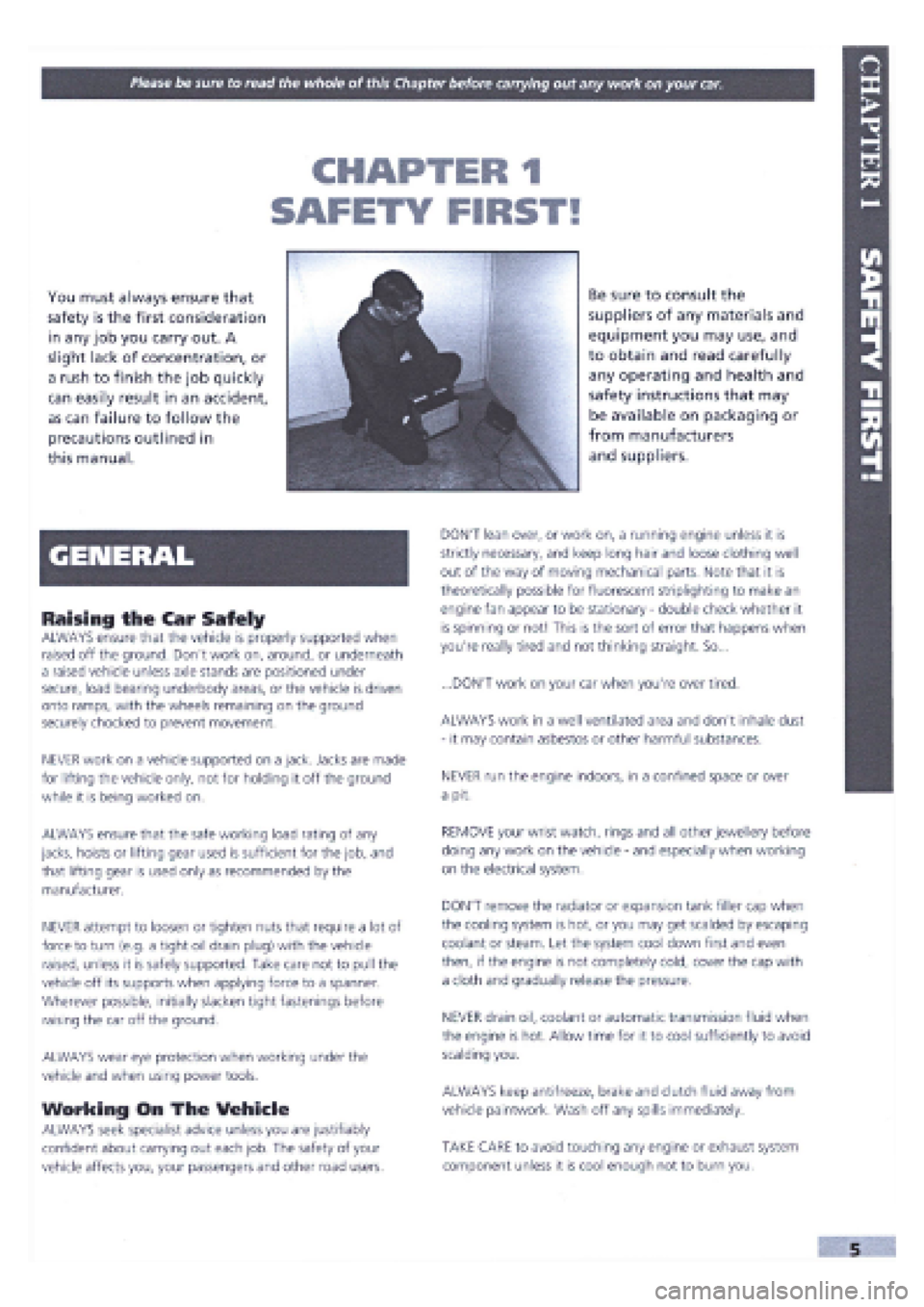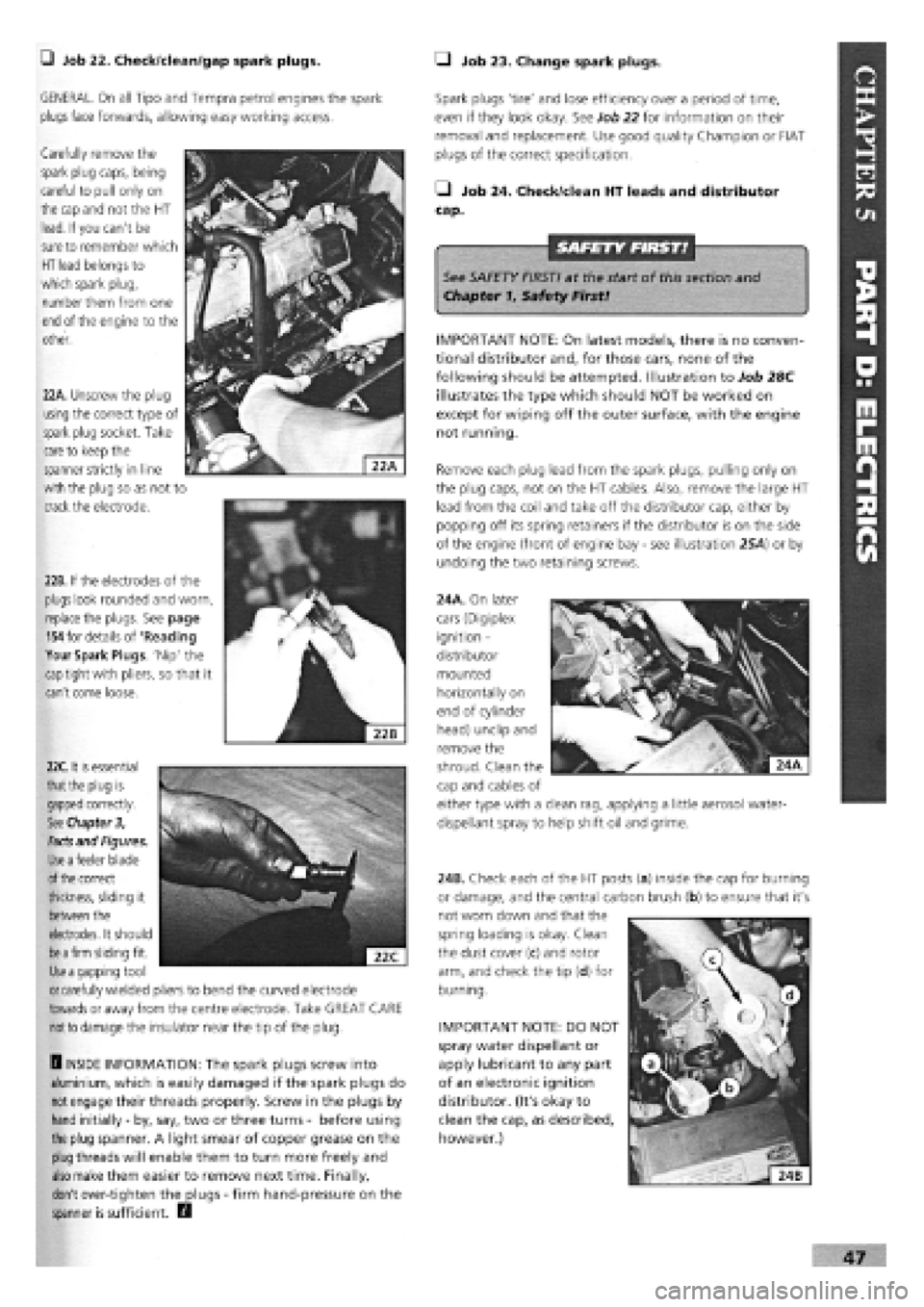tire pressure FIAT TEMPRA 1988 Service And Repair Manual
[x] Cancel search | Manufacturer: FIAT, Model Year: 1988, Model line: TEMPRA, Model: FIAT TEMPRA 1988Pages: 171, PDF Size: 18.05 MB
Page 1 of 171

Please be sure to read the whole of this Chapter before carrying out any work on your car.
SAFETY FIRST!
You must always ensure that
safety is the first consideration
in any job you carry out. A
slight lack of concentration, or
a rush to finish the job quickly
can easily result in an accident,
as can failure to follow the
precautions outlined in
this manual.
Be sure to consult the
suppliers of any materials and
equipment you may use, and
to obtain and read carefully
any operating and health and
safety instructions that may
be available on packaging or
from manufacturers
and suppliers.
Raising the Car Safely
ALWAYS ensure that the vehicle is properly supported when
raised off the ground. Don't work on, around, or underneath
a raised vehicle unless axle stands are positioned under
secure, load bearing underbody areas, or the vehicle is driven
onto ramps, with the wheels remaining on the ground
securely chocked to prevent movement.
NEVER work on a vehicle supported on a jack. Jacks are made
for lifting the vehicle only, not for holding it off the ground
while it is being worked on.
ALWAYS ensure that the safe working load rating of any
jacks, hoists or lifting gear used is sufficient for the job, and
that lifting gear is used only as recommended by the
manufacturer.
NEVER attempt to loosen or tighten nuts that require a lot of
force to turn (e.g. a tight oil drain plug) with the vehicle
raised, unless it is safely supported. Take care not to pull the
vehicle off its supports when applying force to a spanner.
Wherever possible, initially slacken tight fastenings before
raising the car off the ground.
ALWAYS wear eye protection when working under the
vehicle and when using power tools.
Working On The Vehicle
ALWAYS seek specialist advice unless you are justifiably
confident about carrying out each job. The safety of your
vehicle affects you, your passengers and other road users.
DON'T lean over, or work on, a running engine unless it is
strictly necessary, and keep long hair and loose clothing well
out of the way of moving mechanical parts. Note that it is
theoretically possible for fluorescent striplighting to make an
engine fan appear to be stationary
-
double check whether it
is spinning or not! This is the sort of error that happens when
you're really tired and not thinking straight. So...
...DON'T work on your car when you're over tired.
ALWAYS work in a well ventilated area and don't inhale dust
- it may contain asbestos or other harmful substances.
NEVER run the engine indoors, in a confined space or over
a pit.
REMOVE your wrist watch, rings and all other jewellery before
doing any work on the vehicle
-
and especially when working
on the electrical system.
DON'T remove the radiator or expansion tank filler cap when
the cooling system is hot, or you may get scalded by escaping
coolant or steam. Let the system cool down first and even
then, if the engine is not completely cold, cover the cap with
a cloth and gradually release the pressure.
NEVER drain oil, coolant or automatic transmission fluid when
the engine is hot. Allow time for it to cool sufficiently to avoid
scalding you.
ALWAYS keep antifreeze, brake and clutch fluid away from
vehicle paintwork. Wash off any spills immediately.
TAKE CARE to avoid touching any engine or exhaust system
component unless it is cool enough not to burn you.
Page 43 of 171

J Job 22. Check/clean/gap spark plugs. Q Job 23. Change spark plugs.
GENERAL. On all Tipo and Tempra petrol engines the spark
plugs
face forwards, allowing easy working access.
Carefully remove the
spark plug caps, being
careful to pull only on
the cap and
not the HT
lead. If you can't be
sure
to remember which
HT lead
belongs to
which spark plug,
number them from one
end
of the engine to the
other.
22B. If the electrodes of the
plugs look rounded and worn,
replace
the plugs. See page
154
for details of 'Reading
Your Spark Plugs. Nip' the
cap
tight with pliers, so that it
can't come loose.
Spark plugs 'tire' and lose efficiency over a period of time,
even if they look okay. See Job 22 for information on their
removal and replacement. Use good quality Champion or FIAT
plugs of the correct specification.
• Job 24. Check/dean HT leads and distributor
cap.
See SAFETY FIRST! at the start of this section and
Chapter 1, Safety First!
IMPORTANT NOTE: On latest models, there is no conven-
tional distributor and, for those cars, none of the
following should be attempted. Illustration to Job 28C
illustrates the type which should NOT be worked on
except for wiping off the outer surface, with the engine
not running.
Remove each plug lead from the spark plugs, pulling only on
the plug caps, not on the HT cables. Also, remove the large HT
lead from the coil and take off the distributor cap, either by
popping off its spring retainers if the distributor is on the side
of the engine (front of engine bay
-
see illustration 25A) or by
undoing the two retaining screws.
24A. On later
cars (Digiplex
ignition -
distributor
mounted
horizontally on
end of cylinder
head) unclip and
remove the
22A. Unscrew the plug
using
the correct type of
spark plug socket. Take
care
to keep the
spanner strictly in line
with the plug so as not to
crack the electrode.
22C.
it
is
essential
that the
plug is
gapped
correctly.
See Chapter 3,
Facts
and Figures.
Use a
feeler blade
of the
correct
thickness, sliding it
between
the
electrodes. It should
be a firm
sliding fit.
Use a
gapping tool
or
carefully wielded pliers to bend the curved electrode
towards
or away from the centre electrode. Take GREAT CARE
not to
damage the insulator near the tip of the plug.
H INSIDE INFORMATION: The spark plugs screw into
aluminium, which is easily damaged if the spark plugs do
not
engage their threads properly. Screw in the plugs by
hand initially
-
by, say, two or three turns
-
before using
the plug spanner. A light smear of copper grease on the
plug
threads will enable them to turn more freely and
also
make them easier to remove next time. Finally,
don't over-tighten the plugs
-
firm hand-pressure on the
spanner is sufficient. D
IMPORTANT NOTE: DO NOT
spray water dispellant or
apply lubricant to any part
of an electronic ignition
distributor. (It's okay to
clean the cap, as described,
however.)
shroud. Clean the
cap and cables of
either type with a clean rag, applying a little aerosol water-
dispellant spray to help shift oil and grime.
24B. Check each of the HT posts (a) inside the cap for burning
or damage, and the central carbon brush (b) to ensure that it's
not worn down and that the
spring loading is okay. Clean
the dust cover (c) and rotor
arm, and check the tip (d) for
burning.